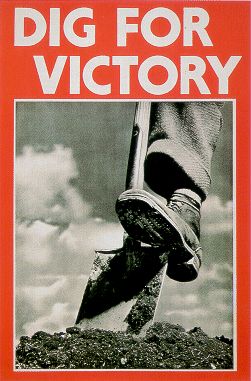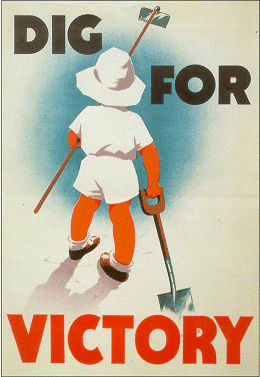
The Ministry of Agriculture launched one month on from the outbreak of the Second World War, one of the most memorable slogans of the whole conflict - 'Dig for Victory'. From this point on, the whole of Britain's home front were encouraged to transform their private gardens into mini-allotments. It was believed, quite rightly, that this would not only provide essential crops for families and neighbourhoods alike, but help the war effort by freeing up valuable space for war materials on the merchant shipping convoys. Indeed, over just a few months, Britain saw its green and pleasant land transformed with gardens, flowerbeds and parkland dug up for the plantation of vegetables.
By 1943, over a million tons of vegetables were being grown in gardens and allotments.
During the course of the war, many propagandist moves were made to promote the importance of 'growing your own'. In addition to the circulation of familiar Ministry of Agriculture 'food flashes', literature and poster displays, anthems were also introduced. One such 'Dig for Victory' anthem is shown to the right.



Carrots were one vegetable in plentiful supply and as a result widely utilised as a substitute for the more scarce commodities. To improve its blandness, people were encouraged to 'enjoy' the healthy carrot in different ways by the introduction of such characters as 'Doctor Carrot'. Culinary delights in the form of curried carrot, carrot jam and a homemade drink called Carrolade (made up from the juices of carrots and Swede!) were suggested by the Ministry of Agriculture.

Similarly to the 'Doctor Carrot' character, but this time using potatoes, 'Potato Pete' was another character introduced to encourage the population to eat home grown vegetables.
As with the Dig for Victory theme, 'Potato Pete' also had its own song amplifying its message. Vocals by Betty Driver (known by millions today as Betty Williams in Coronation Street'), the recording was a great success and did a tremendous amount of good in getting the message across. 'Potato Pete' recipe books were also written to give women suggestions and advice on how best serve potatoes at mealtimes. For example, 'scrubbing instead of peeling potatoes' was recommended, thus avoiding unnecessary wastage. Even traditional nursery rhymes were adapted to give a 'Potato Pete' theme!
An example of a slogan for 'Potato Pete' is shown to the right.
One poem with the theme based around the 'Potato Pete' character
Lorem ipsum dolor sit amet, consectetur adipisicing elit. Quo eius debitis enim, deserunt repellendus vitae odit natus optio. Nisi quod dolore ex eius voluptate accusantium rem ab maxime autem debitis!

PICTURE: A jovial Doctor Carrot and jumping Potato Pete
It was clear that as the war progressed, the Dig for Victory campaign had exceeded all expectations in terms of success.
However, as the following 1944 message from the Minister of Agriculture to all gardeners and allotment holders suggests, complacency in efforts were to be avoided despite the anticipated end of the war only being a few months away. There was clearly still a lot of work to be done, even after the war!

As a dedicated, high profile Minister of Food (April 1940 - December 1943) Lord (Frederick James Marquis, first Earl of) Woolton was responsible for selling the benefits of rationing to the British public and educating it into better eating habits. Later in the war, with plentiful vegetables being produced as a result of the success of the 'Dig for Victory' campaign, some were used as the ingredients for the legendary 'Woolton Pie'. This particular vegetable pie recipe was made from potatoes, parsnips and herbs - click on link to see full recipe). Alas though, this particular dish never really took off with the British public.
Fresh eggs were also produced as people realised the value of keeping chickens in their back yards. The importance of retaining edible scraps of food for pigs was also evoked. These pigs, some of which were purchased with monies collected from organised neighbourhood schemes, once fattened with the scraps, yielded good food too. Pig schemes were often called Pig Clubs.